- 1Ubuntu搭建samba服务器教程_ubuntu smbclient
- 2AurixDevStudio集成MCAL_aurix develop mcal
- 3AI Agent行业报告:框架拆解、应用方向、应用领域及相关公司深度梳理_ai agent行业报告:
- 4微软 x 国科大从底层掀翻大语言模型!1-bit LLMs 能推动 AI 硬件革命吗?
- 5AI赋能微服务:Spring Boot与机器学习驱动的未来应用开发
- 6基于spring boot的汽车4s店管理系统
- 7spring-boot如何启动WEB项目之二
- 8鸿蒙系统如何实现同步,鸿蒙系统中如何实现页面间跳转?
- 9Java基础学习: hutool之CollUtil集合操作工具类
- 10【机器学习】李宏毅——Adversarial Attack(对抗攻击)_李宏毅 对抗训练
最简单、通俗地理解GPT的Transformer架构:从零开始编写 Transformer_快速搭建的transformer框架
赞
踩
学习Transformer,快来跟着我动手写一个。
作为算法同学,学习 Transformer 中,不动手写一个。纸上得来终觉浅,绝知此事要躬行,抽空多debug几遍!
注:不涉及算法解释,仅是从代码实现去加强理解。
一、准备知识
以预测二手房价格的模型,先来理解机器学习中的核心概念。
1.1、手撸版
1、准备训练数据
# 样本数
num_examples = 1000
# 特征数:房屋大小、新旧
num_input = 2
# 线性回归模型,2个W参数值:2,-3.4
true_w = [2, -3.4]
# 1个b参数值
true_b = 4.2
# 随机生成样本:特征值
features = torch.randn(num_examples, num_input, dtype=torch.float32)
# print(features[0])
# 随机生成样本:y值
labels = true_w[0] * features[:, 0] + true_w[1] * features[:, 1] + true_b
# print(labels[0])
# 随机生成一批数据,给y值再随机化下
_temp = torch.tensor(np.random.normal(0, 0.01, size=labels.size()), dtype=torch.float32)
labels = labels + _temp
# print(labels[0])
- 1
- 2
- 3
- 4
- 5
- 6
- 7
- 8
- 9
- 10
- 11
- 12
- 13
- 14
- 15
- 16
- 17
- 18
- 19
- 20
2、定义模型
# 模型参数 w:w1、w2,b:b,设了初始值
w = torch.tensor(np.random.normal(0, 0.01, (num_input, 1)), dtype=torch.float32)
b = torch.zeros(1, dtype=torch.float32)
# 设置要求计算梯度
w.requires_grad_(requires_grad=True)
b.requires_grad_(requires_grad=True)
# 线性回归模型:定义 torch.mm(X, w) + b,mm是矩阵乘法(m:multiply缩写)
def linreg(X, w, b):
return torch.mm(X, w) + b
# 定义损失函数:y_pred=预测值、y=真实值,最简单的 平方误差
def squared_loss(y_pred, y):
return (y_pred - y.view(y_pred.size())) ** 2 / 2
# 定义梯度下降算法:sgd
# params是参数(data 是参数值、grad 是梯度值),lr是学习率,batch是数量
# 为什么要除batch?因为这个梯度值,是在batch个数据上累加算的
def sgd(params, lr, batch):
for param in params:
# 注意这里更改param时用的param.data
param.data -= lr * param.grad / batch
- 1
- 2
- 3
- 4
- 5
- 6
- 7
- 8
- 9
- 10
- 11
- 12
- 13
- 14
- 15
- 16
- 17
- 18
- 19
- 20
- 21
- 22
3、训练模型
# 初始学习率
lr = 0.03
# 训练轮次
epoch = 5
# 网络:一层,2个输入(2个参数 w1、w2),1个b参数
net = linreg
# 损失函数
loss = squared_loss
# 1个批次大小
batch_size = 10
# 训练模型一共需要epoch个迭代周期
for epoch in range(epoch):
# 在每一个迭代周期中,所有样本都要跑,从 0~1000,每个batch=10
for X, y in data_iter(batch_size, features, labels):
# ls是这个batch的损失求和
ls = loss(net(X, w, b), y).sum()
# 求梯度值
ls.backward()
# 更新参数
sgd([w, b], lr, batch_size)
# 不要忘了梯度清零,下一次要用
w.grad.data.zero_()
b.grad.data.zero_()
# 在计算这轮训练完后,打印 loss,可以观察在不断变小
train_l = loss(net(features, w, b), labels)
print('epoch %d, loss %f' % (epoch + 1, train_l.mean().item()))
- 1
- 2
- 3
- 4
- 5
- 6
- 7
- 8
- 9
- 10
- 11
- 12
- 13
- 14
- 15
- 16
- 17
- 18
- 19
- 20
- 21
- 22
- 23
- 24
- 25
- 26
- 27
- 28
辅助函数:by batch & 随机,读取样本数据
# 定义随机读取数据 by batch
def data_iter(batch, features, labels):
nums = len(features)
# 生成 0-1000 数组
indices = list(range(nums))
# 打乱下标的读取顺序
random.shuffle(indices)
# 生成:start=0,stop=1000,step=batch=10
for i in range(0, nums, batch):
# 截取一段下标,size=batch
t_ind = indices[i: min(i + batch, num_examples)] # 最后一次可能不足一个batch
# 转换为torch要求格式:tensor
j = torch.LongTensor(t_ind)
# 按照下标从向量中找
# yield:生成一个迭代器返回,有点类似闭包,每调用一次返回一次,且下次调用时会从上次暂停的位置继续
yield features.index_select(0, j), labels.index_select(0, j)
- 1
- 2
- 3
- 4
- 5
- 6
- 7
- 8
- 9
- 10
- 11
- 12
- 13
- 14
- 15
- 16
技术交流
建了技术交流群!想要进交流群、获取如下原版资料的同学,可以直接加微信号:dkl88194。加的时候备注一下:研究方向 +学校/公司+CSDN,即可。然后就可以拉你进群了。
方式①、添加微信号:dkl88194,备注:来自CSDN + 技术交流
方式②、微信搜索公众号:Python学习与数据挖掘,后台回复:加群
资料1

资料2
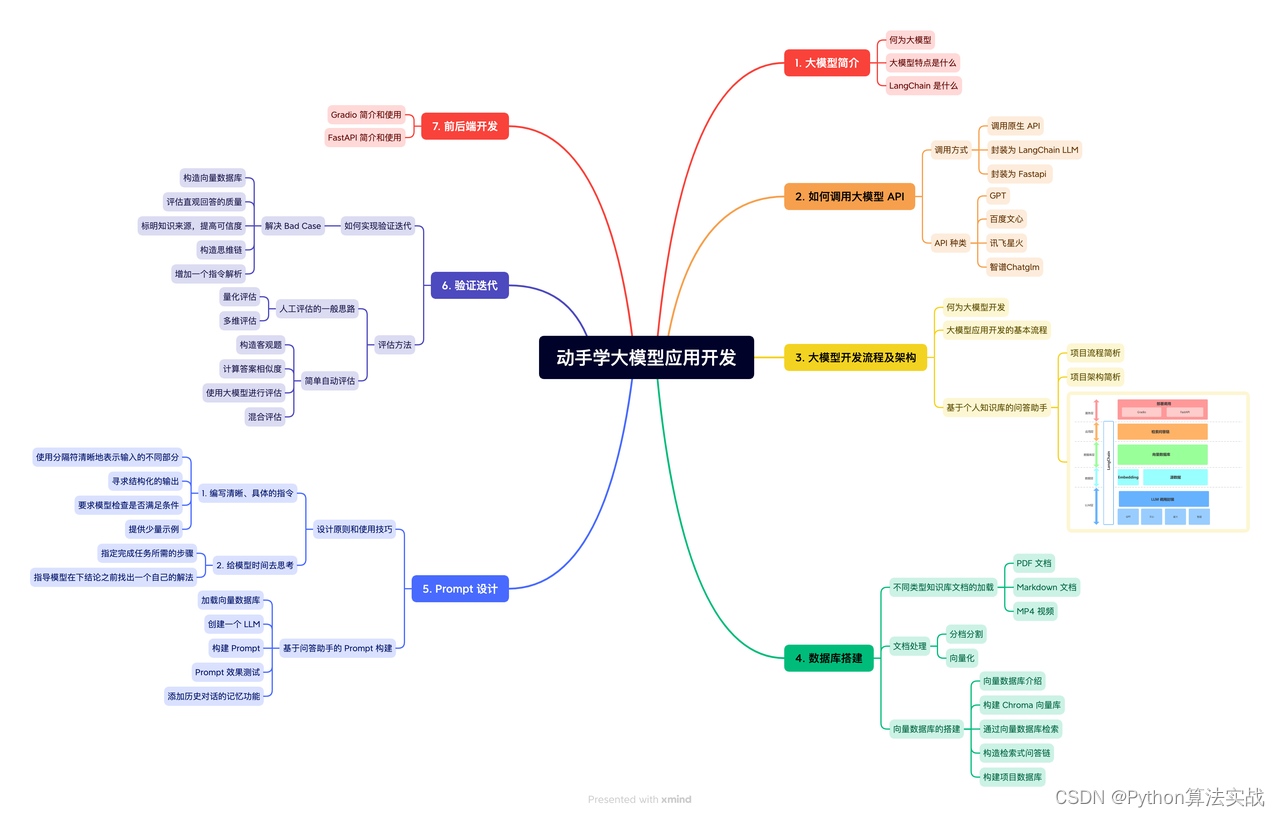
1.2、pytorch版
1、准备训练数据
同上
2、定义模型
# 定义模型:线性回归
class LinearNet(nn.Module):
def __init__(self, n_feature):
super(LinearNet, self).__init__()
# 线性规划:n_feature=几个w,1=1个b
self.linear = nn.Linear(n_feature, 1)
# forward 定义【前向传播】
def forward(self, x):
y = self.linear(x)
return y
# 实例化模型,初始化参数值
net = LinearNet(num_input)
init.normal_(net[0].weight, mean=0, std=0.01)
init.constant_(net[0].bias, val=0)
# 定义损失函数
loss = nn.MSELoss()
# 定义梯度下降算法(lr是学习率)
optimizer = optim.SGD(net.parameters(), lr=0.03)
- 1
- 2
- 3
- 4
- 5
- 6
- 7
- 8
- 9
- 10
- 11
- 12
- 13
- 14
- 15
- 16
- 17
- 18
- 19
- 20
- 21
- 22
3、训练模型
num_epochs = 3
for epoch in range(1, num_epochs + 1):
for X, y in data_iter:
output = net(X)
# 算损失值
l_sum = loss(output, y.view(-1, 1))
# 更新梯度
l_sum.backward()
# 更新w和b
optimizer.step()
# 梯度清零
optimizer.zero_grad()
print('epoch %d, loss: %f' % (epoch, l_sum.item()))
- 1
- 2
- 3
- 4
- 5
- 6
- 7
- 8
- 9
- 10
- 11
- 12
- 13
batch 读取数据
# 读取数据 by batch & 随机
batch_size = 10
data_set = Data.TensorDataset(features, labels)
data_iter = Data.DataLoader(data_set, batch_size, shuffle=True)
- 1
- 2
- 3
- 4
在用torch框架,进一步要理解:
a、nn.Module 和 forward() 函数:表示神经网络中的一个层,覆写 init 和 forward 方法(提问:实现2层网络怎么做?)
b、debug 观察下数据变化,和 手撸版 对比着去理解
二、手写Transformer
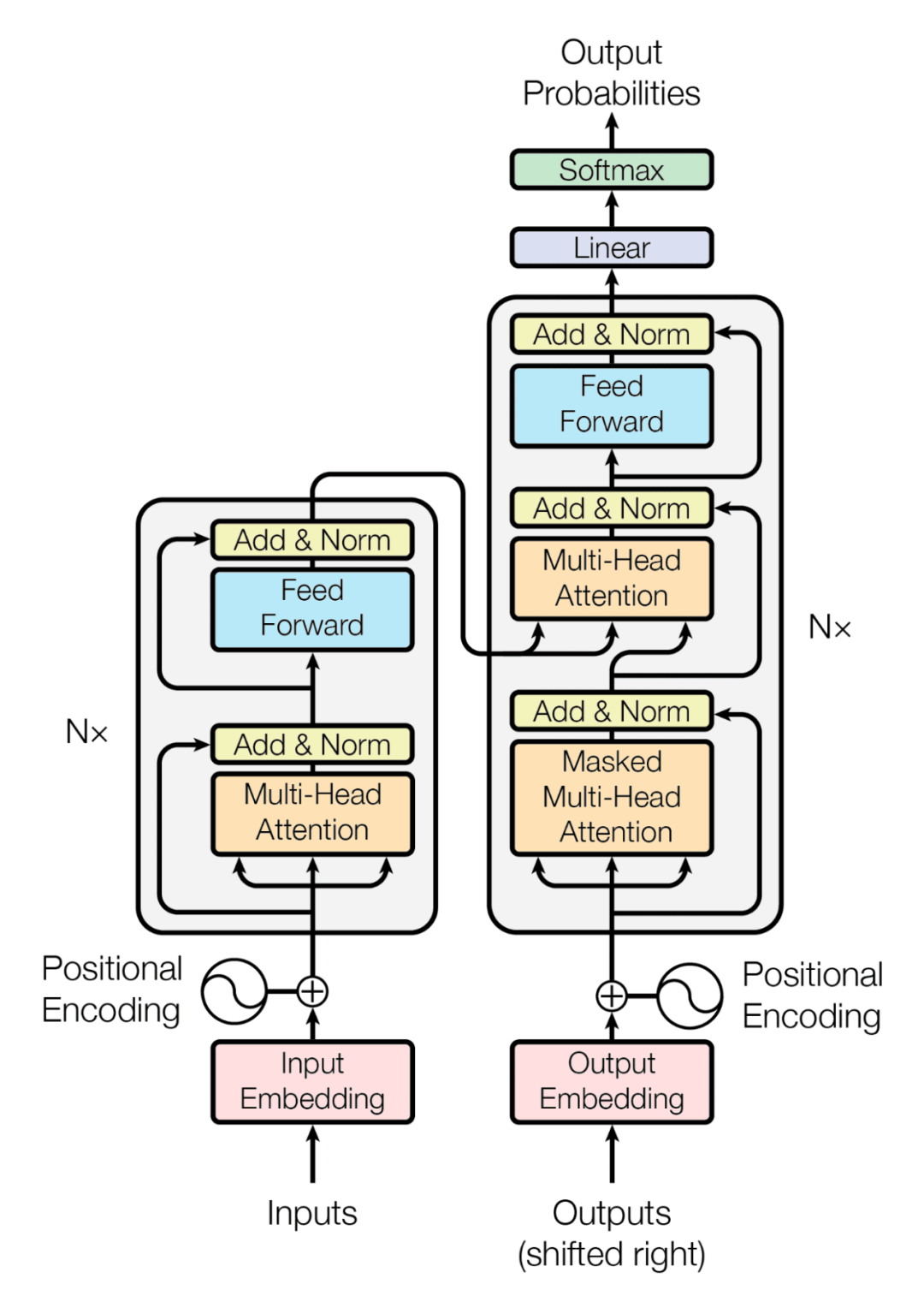
上面这是一个"逻辑"示意图。印象中,第1次看时,以为 “inputs & outputs” 是并行计算、但上面又有依赖,很糊涂。
这不是一个技术架构图,上图有很多概念,attention、multi-head等。先尝试转换为面向对象的类图,如下:
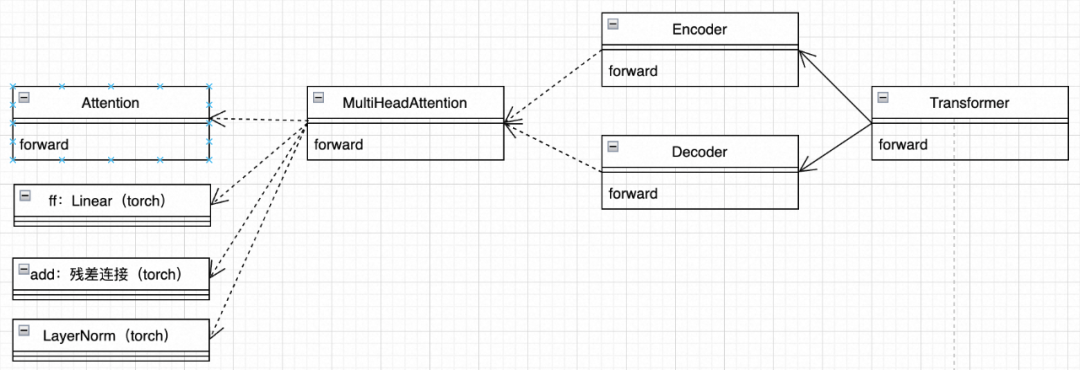
2.1、例子:翻译
# 定义词典
source_vocab = {'E': 0, '我': 1, '吃': 2, '肉': 3}
target_vocab = {'E': 0, 'I': 1, 'eat': 2, 'meat': 3, 'S': 4}
# 样本数据
encoder_input = torch.LongTensor([[1, 2, 3, 0]]).to(device) # 我 吃 肉 E, E代表结束词
decoder_input = torch.LongTensor([[4, 1, 2, 3]]).to(device) # S I eat meat, S代表开始词, 并右移一位,用于并行训练
target = torch.LongTensor([[1, 2, 3, 0]]).to(device) # I eat meat E, 翻译目标
- 1
- 2
- 3
- 4
- 5
- 6
- 7
- 8
2.2、定义模型
按照上面类图,我们来一点点实现
1、Attention
class ScaledDotProductAttention(nn.Module):
def __init__(self):
super(ScaledDotProductAttention, self).__init__()
def forward(self, Q, K, V, attn_mask):
# Q、K、V,此时是已经乘过 W(q)、W(k)、W(v) 矩阵
# 如下图,但不用一个个算,矩阵乘法一次搞定
scores = torch.matmul(Q, K.transpose(-1, -2)) / np.sqrt(d_k)
# 遮盖区的值设为近0,表示E结尾 or decoder 自我顺序遮盖,注意力丢弃
scores.masked_fill_(attn_mask, -1e9)
# softmax后(遮盖区变为0)
attn = nn.Softmax(dim=-1)(scores)
# 乘积意义:给V带上了注意力信息。prob就是下图z(矩阵计算不用在v1+v2)。
prob = torch.matmul(attn, V)
return prob
- 1
- 2
- 3
- 4
- 5
- 6
- 7
- 8
- 9
- 10
- 11
- 12
- 13
- 14
- 15
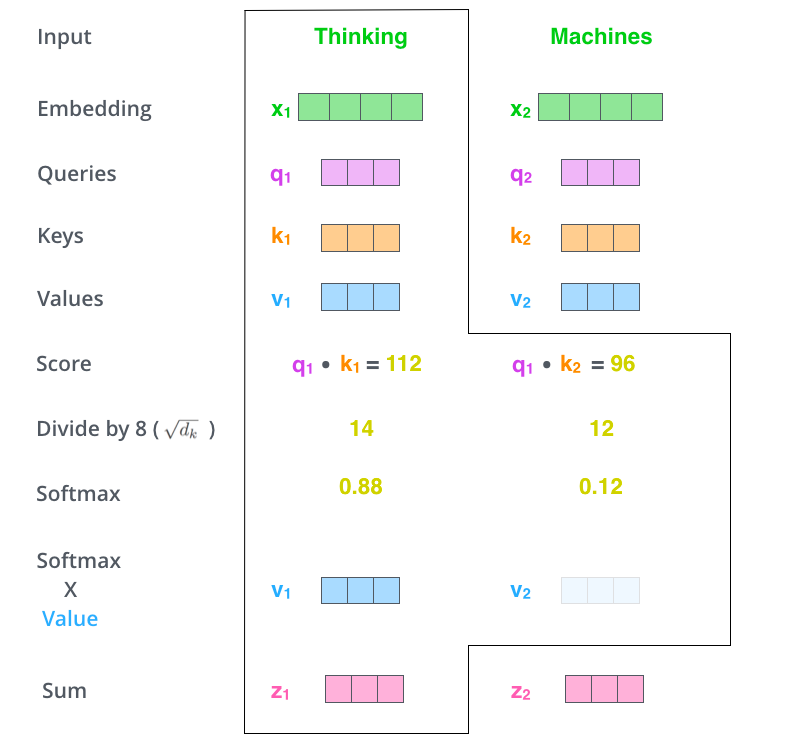
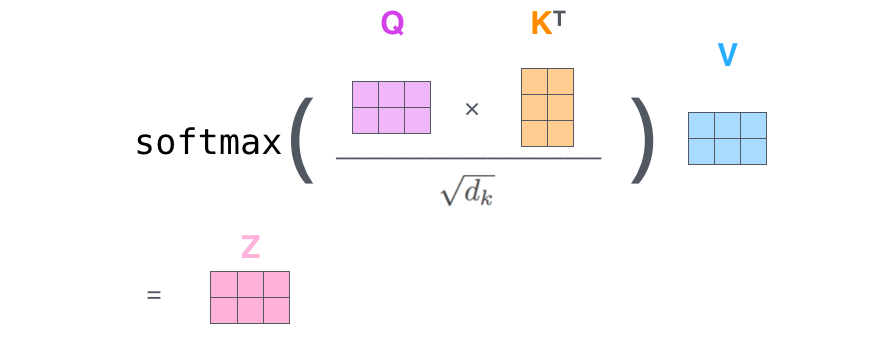
2、MultiHeadAttention
通用变量定义
d_model = 6 # embedding size
# d_model = 3 # embedding size
d_ff = 12 # feedforward nerual network dimension
d_k = d_v = 3 # dimension of k(same as q) and v
n_heads = 2 # number of heads in multihead attention
# n_heads = 1 # number of heads in multihead attention【注:为debug更简单,可以先改为1个head】
p_drop = 0.1 # propability of dropout
device = "cpu"
- 1
- 2
- 3
- 4
- 5
- 6
- 7
- 8
注1:按惯性会想,会有多个head、串行循环计算,不是,多个head是一个张量输入
注2:FF 全连接、残差连接、归一化,35、38 行业代码,pytorch框架带来的简化
class MultiHeadAttention(nn.Module):
def __init__(self):
super(MultiHeadAttention, self).__init__()
self.n_heads = n_heads
self.W_Q = nn.Linear(d_model, d_k * n_heads, bias=False)
self.W_K = nn.Linear(d_model, d_k * n_heads, bias=False)
self.W_V = nn.Linear(d_model, d_v * n_heads, bias=False)
self.fc = nn.Linear(d_v * n_heads, d_model, bias=False) # ff 全连接
self.layer_norm = nn.LayerNorm(d_model) # normal 归一化
def forward(self, input_Q, input_K, input_V, attn_mask):
# input_Q:1*4*6,每批1句 * 每句4个词 * 每词6长度编码
# residual 先临时保存下:原始值,后面做残差连接加法
residual, batch = input_Q, input_Q.size(0)
# 乘上 W 矩阵。注:W 就是要训练的参数
# 注意:维度从2维变成3维,增加 head 维度,也是一次性并行计算
Q = self.W_Q(input_Q) # 乘以 W(6*6) 变为 1*4*6
Q = Q.view(batch, -1, n_heads, d_k).transpose(1, 2) # 切开为2个Head 变为 1*2*4*3 1批 2个Head 4词 3编码
K = self.W_K(input_K).view(batch, -1, n_heads, d_k).transpose(1, 2)
V = self.W_V(input_V).view(batch, -1, n_heads, d_v).transpose(1, 2)
# 1*2*4*4,2个Head的4*4,最后一列为true
# 因为最后一列是 E 结束符
attn_mask = attn_mask.unsqueeze(1).repeat(1, n_heads, 1, 1)
# 返回1*2*4*3,2个头,4*3为带上关注关系的4词
prob = ScaledDotProductAttention()(Q, K, V, attn_mask)
# 把2头重新拼接起来,变为 1*4*6
prob = prob.transpose(1, 2).contiguous()
prob = prob.view(batch, -1, n_heads * d_v).contiguous()
# 全连接层:对多头注意力的输出进行线性变换,从而更好地提取信息
output = self.fc(prob)
# 残差连接 & 归一化
res = self.layer_norm(residual + output) # return 1*4*6
return res
- 1
- 2
- 3
- 4
- 5
- 6
- 7
- 8
- 9
- 10
- 11
- 12
- 13
- 14
- 15
- 16
- 17
- 18
- 19
- 20
- 21
- 22
- 23
- 24
- 25
- 26
- 27
- 28
- 29
- 30
- 31
- 32
- 33
- 34
- 35
- 36
- 37
- 38
- 39
3、Encoder
在 attention 概念中,有很关键的 “遮盖” 概念,先不细究,你debug一遍会更理解
def get_attn_pad_mask(seq_q, seq_k): # 本质是结尾E做注意力遮盖,返回 1*4*4,最后一列为True
batch, len_q = seq_q.size() # 1, 4
batch, len_k = seq_k.size() # 1, 4
pad_attn_mask = seq_k.data.eq(0).unsqueeze(1) # 为0则为true,变为f,f,f,true,意思是把0这个结尾标志为true
return pad_attn_mask.expand(batch, len_q, len_k) # 扩展为1*4*4,最后一列为true,表示抹掉结尾对应的注意力
def get_attn_subsequent_mask(seq): # decoder的自我顺序注意力遮盖,右上三角形区为true的遮盖
attn_shape = [seq.size(0), seq.size(1), seq.size(1)]
subsequent_mask = np.triu(np.ones(attn_shape), k=1)
subsequent_mask = torch.from_numpy(subsequent_mask)
return subsequent_mask
- 1
- 2
- 3
- 4
- 5
- 6
- 7
- 8
- 9
- 10
- 11
- 12
class Encoder(nn.Module):
def __init__(self):
super(Encoder, self).__init__()
self.source_embedding = nn.Embedding(len(source_vocab), d_model)
self.attention = MultiHeadAttention()
def forward(self, encoder_input):
# input 1 * 4,1句话4个单词
# 1 * 4 * 6,将每个单词的整数字编码扩展到6个浮点数编码
embedded = self.source_embedding(encoder_input)
# 1 * 4 * 4 矩阵,最后一列为true,表示忽略结尾词的注意力机制
mask = get_attn_pad_mask(encoder_input, encoder_input)
# 1*4*6,带上关注力的4个词矩阵
encoder_output = self.attention(embedded, embedded, embedded, mask)
return encoder_output
- 1
- 2
- 3
- 4
- 5
- 6
- 7
- 8
- 9
- 10
- 11
- 12
- 13
- 14
- 15
4、Decoder
class Decoder(nn.Module):
def __init__(self):
super(Decoder, self).__init__()
self.target_embedding = nn.Embedding(len(target_vocab), d_model)
self.attention = MultiHeadAttention()
# 三入参形状分别为 1*4, 1*4, 1*4*6,前两者未被embedding,注意后面这个是 encoder_output
def forward(self, decoder_input, encoder_input, encoder_output):
# 编码为1*4*6
decoder_embedded = self.target_embedding(decoder_input)
# 1*4*4 全为false,表示没有结尾词
decoder_self_attn_mask = get_attn_pad_mask(decoder_input, decoder_input)
# 1*4*4 右上三角区为1,其余为0
decoder_subsequent_mask = get_attn_subsequent_mask(decoder_input)
# 1*4*4 右上三角区为true,其余为false
decoder_self_mask = torch.gt(decoder_self_attn_mask + decoder_subsequent_mask, 0)
# 1*4*6 带上注意力的4词矩阵【注:decoder里面,第1个attention】
decoder_output = self.attention(decoder_embedded, decoder_embedded, decoder_embedded, decoder_self_mask)
# 1*4*4 最后一列为true,表示E结尾词
decoder_encoder_attn_mask = get_attn_pad_mask(decoder_input, encoder_input)
# 输入均为 1*4*6,Q表示"S I eat meat"、K表示"我吃肉E"、V表示 "我吃肉E"
#【注:decoder里面,第2个attention】
decoder_output = self.attention(decoder_output, encoder_output, encoder_output, decoder_encoder_attn_mask)
return decoder_output
- 1
- 2
- 3
- 4
- 5
- 6
- 7
- 8
- 9
- 10
- 11
- 12
- 13
- 14
- 15
- 16
- 17
- 18
- 19
- 20
- 21
- 22
- 23
- 24
- 25
- 26
- 27
- 28
5、Transformer
class Transformer(nn.Module):
def __init__(self):
super(Transformer, self).__init__()
self.encoder = Encoder()
self.decoder = Decoder()
self.fc = nn.Linear(d_model, len(target_vocab), bias=False)
def forward(self, encoder_input, decoder_input):
# 入 1*4,出 1*4*6,作用:"我吃肉E",并带上三词间的关注力信息
encoder_output = self.encoder(encoder_input)
# 入 1*4, 1*4, 1*4*6=encoder_output
decoder_output = self.decoder(decoder_input, encoder_input, encoder_output)
# 预测出4个词,每个词对应到词典中5个词的概率,如下
# tensor([[[ 0.0755, -0.2646, 0.1279, -0.3735, -0.2351],[-1.2789, 0.6237, -0.6452, 1.1632, 0.6479]]]
decoder_logits = self.fc(decoder_output)
res = decoder_logits.view(-1, decoder_logits.size(-1))
return res
- 1
- 2
- 3
- 4
- 5
- 6
- 7
- 8
- 9
- 10
- 11
- 12
- 13
- 14
- 15
- 16
- 17
2.3、训练模型
model = Transformer().to(device)
criterion = nn.CrossEntropyLoss()
optimizer = optim.Adam(model.parameters(), lr=1e-1)
for epoch in range(10):
# 输出4*5,代表预测出4个词,每个词对应到词典中5个词的概率
output = model(encoder_input, decoder_input)
# 和目标词 I eat meat E做差异计算
loss = criterion(output, target.view(-1))
print('Epoch:', '%04d' % (epoch + 1), 'loss =', '{:.6f}'.format(loss))
# 这个3个操作:清零梯度、算法梯度、更新参数
optimizer.zero_grad()
loss.backward()
optimizer.step()
- 1
- 2
- 3
- 4
- 5
- 6
- 7
- 8
- 9
- 10
- 11
- 12
- 13
- 14
2.4、使用模型
# 预测目标是5个单词
target_len = len(target_vocab)
# 1*4*6 输入"我吃肉E",先算【自注意力】
encoder_output = model.encoder(encoder_input)
# 1*5 全是0,表示EEEEE
decoder_input = torch.zeros(1, target_len).type_as(encoder_input.data)
# 表示S开始字符
next_symbol = 4
# 5个单词逐个预测【注意:是一个个追加词,不断往后预测的】
for i in range(target_len):
# 譬如i=0第一轮,decoder输入为SEEEE,第二轮为S I EEE,把预测 I 给拼上去,继续循环
decoder_input[0][i] = next_symbol
# decoder 输出
decoder_output = model.decoder(decoder_input, encoder_input, encoder_output)
# 负责将解码器的输出映射到目标词汇表,每个元素表示对应目标词汇的分数
# 取出最大的五个词的下标,譬如[1, 3, 3, 3, 3] 表示 i,meat,meat,meat,meat
logits = model.fc(decoder_output).squeeze(0)
prob = logits.max(dim=1, keepdim=False)[1]
next_symbol = prob.data[i].item() # 只取当前i
for k, v in target_vocab.items():
if v == next_symbol:
print('第', i, '轮:', k)
break
if next_symbol == 0: # 遇到结尾了,那就完成翻译
break
- 1
- 2
- 3
- 4
- 5
- 6
- 7
- 8
- 9
- 10
- 11
- 12
- 13
- 14
- 15
- 16
- 17
- 18
- 19
- 20
- 21
- 22
- 23
- 24
- 25
- 26
- 27
- 28
参考资料:
1、https://jalammar.github.io/illustrated-transformer/
2、http://nlp.seas.harvard.edu/annotated-transformer/
3、gpt4:学习过程中有很多疑惑,真是一个好老师


